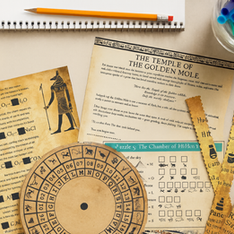How I Create the Perfect Lab Groups in My Science Classroom
- Androy Bruney

- Aug 7
- 3 min read

It always started the same way.
We’d just begun a lab—maybe something hands-on and messy like a reaction between baking soda and vinegar. One student would instantly take charge, snatching the materials and reading directions aloud (loudly). Another would drift toward the background, hands in pockets, avoiding eye contact. A third would quietly ask, “Wait… what are we even doing?”
Meanwhile, I’d be bouncing between groups, trying to keep everyone on task while also enforcing safety, managing time, and answering six unrelated questions.
Sound familiar?
Science labs are supposed to be the highlight of the week. But without structure, they can quickly spiral into chaos, with some students doing all the work and others doing none of it.
After years of tweaking (and a few chaotic labs), I finally landed on a system that makes my lab groups feel balanced, focused, and collaborative—without me having to micromanage.
Here’s how I do it.
How I Create My Lab Groups:
I Don’t Randomize—And Here’s Why
Early in my teaching career, I used to assign groups randomly. It felt fair, quick, and democratic. But what I realized was that fairness doesn’t always mean effectiveness. Some students thrived while others shut down—or worse, coasted under the radar.
Now? I build groups with intention.
Before I even think about grouping, I collect data using a simple student inventory. I ask questions like:
Do you prefer working solo or in a group?
What role do you usually take in group work (leader, note-taker, quiet contributor)?
What’s something that helps you stay focused during a project?
These responses become part of my mental playbook. I use them—not rigidly, but strategically to pair students with complementary strengths, to support quieter voices, and to avoid common friction points.
Defining Roles = Defining Success
Even with balanced groups, things can fall apart if students don’t know what to do.
That’s why having clearly defined roles is important. For every lab, each student gets a specific job, and those jobs change from lab to lab, so everyone gets a turn to shine.
Some of my go-to roles include:
Project Manager – Keeps the team on track and manages the timeline
Materials Manager – Gathers and returns supplies, ensures everything is used safely
Recorder – Takes notes and records data accurately
Data Manager – Organizes results and helps make sense of what they mean
Safety Officer – Makes sure safety rules are followed during the lab
Facilitator – Keeps everyone involved and encourages group communication
I use editable role cards to assign these roles quickly and clearly. Sometimes I print them onto sticky notes for easy handouts, or display them on the board using classroom slides with built-in timers to keep the group moving through each phase of the lab.
And no, it doesn’t take a ton of time. Once the system is in place, it saves me time and helps avoid so many of the classic group work pitfalls.
Built-In Accountability (Without Micromanaging)
We all know what happens when one student does all the work. That’s why I make expectations clear from the start—with a group participation rubric that outlines what collaboration should look like, and a simple reflection sheet students fill out at the end of each project.
This doesn’t just improve group dynamics. It also helps students develop self-awareness and ownership of their roles. Some of my best classroom moments have come from students realizing, “I actually liked being the recorder!” or “Next time, I want to try managing the data.”
A Few Final Tips for Creating Science Lab Groups That Work
Use student insight, not guesswork. A quick inventory at the start of the year (and maybe again mid-year) gives you powerful grouping data.
Be flexible. Sometimes, the same student needs structure one week and freedom the next.
Rotate roles. This keeps things fair and lets students discover new strengths.
Keep the system visible. Use timers, group slides, and role cards so students know what's expected.
Reflect regularly. Group work is a skill, and like any skill, it improves with practice and reflection.
Ready to Try It?
If you’re tired of chaotic group work and want something more intentional, I’ve put together a resource that includes everything I use:
Editable Group Role Cards
Printable Sticky Note Templates
Management Slides with Timers
Group Participation Rubric
Student Reflection Sheet
It’s fully editable, flexible enough for any grade level, and designed to make your science labs feel more like real teamwork—and less like herding cats.
Check out the full resource here and bring more structure (and sanity) to your next group lab.
Final Thought
Perfect lab groups don’t just happen. They’re built with intention, clarity, and a little structure. When students know their roles, understand each other, and feel seen by their teacher, science becomes what it should be: collaborative, curious, and fun.
And isn’t that the kind of classroom we’re all trying to build?

















Comments